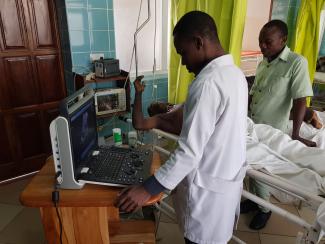Staff and infrastructure
Emergency care in rural Tanzania

An emergency department is vital for providing immediate and adequate assistance to seriously ill or injured patients. If such help is unavailable, that all too often amounts to a death sentence. Cases of severe sepsis or bleeding, for example, cannot be effectively treated in an outpatient clinic. Many patients do not get timely help, and diagnoses are frequently incorrect.
Setting up an emergency unit requires organisation, training and a certain amount of hardware. At St. Francis, we reorganised outpatient staffing to permit 24-hour emergency care. A three-shift work schedule was established. We also set up what is known as a triage system. It prioritises patients according to the severity of their illness or injury. Each patient is first seen by a nurse, who checks blood pressure, pulse, temperature and oxygen saturation and then assigns the patient to one of three urgency level categories based on a score card (South African Triage Scale, SATS).
This method allows us to identify critically ill patients and take them to the emergency room immediately. The emergency team can then make the diagnosis fast and start treatment. Less ill patients stay in the waiting room until they are seen by other emergency-unit doctors a bit later. Patients are registered and pay for the hospital service only once the triage process is completed. Emergency medication is similarly administered to patients right away and paid for later.
In the emergency room, staff can rely on good infrastructure. It includes four patient monitors, two ultrasound machines, a defibrillator, an electrocardiogram (ECG) machine, non-invasive airway management equipment, a suction pump, a nebuliser for inhalation medication and a thoracic drainage system. The equipment also includes rapid-test kits to determine blood-sugar levels, check for malaria, HIV and pregnancy. Urine tests, syringes, cannulas, gloves and intravenous fluid, catheters and emergency drugs are readily available. This year we plan to introduce a point-of-care system for blood gas analysis and a blood chemistry laboratory.
The emergency staff include six fully trained clinicians (medical doctors, clinical officers, assistant medical officers) and four junior doctors on internship (intern doctors on two-month rotation) as well as 13 nurses. It is important that staff continuously update their training in emergency medicine, ultrasound and echocardiography. This is done according to the “train the trainers” principle, where personnel with greater expertise instruct less experienced colleagues. Training takes place daily at the patient bedside, during daily handover reporting and in emergency and ultrasound courses.
Since our project was launched, we have trained around 30 physicians and nursing staff in emergency care. Nine clinicians, four of them working at the emergency department, have successfully completed the point of care ultrasound exam according to the standards of the EFSUMB (European Federation of Societies for Ultrasound in Medicine and Biology). They now supervise less experienced colleagues in daily practice and instruct others in ultrasound courses. A further 80 or so newly qualified young doctors have worked at the hospital for a year, gained insights into emergency care and ultrasound application.
We treat 36,000 adults and children a year at the emergency department. Journeys to the hospital are often long and arduous due to poor roads. Moreover, people in our region tend to have little money and no health insurance, while their farms demand constant attention. For these reasons, many patients only come to the hospital when their condition is advanced. Once diagnosed, patients in desperate need are first treated and stabilised in the emergency room and then transferred in better condition to the operating theatre or another ward. In the best cases, they can be discharged to go home.
We are able to treat the major ailments: sepsis and other infectious diseases such as pneumonia or malaria are tackled by rapidly administering fluids and antibiotics. In the case of accidents that result in internal injuries, we transfer patients directly to the operating theatre – for example to stop internal bleeding, to remove a ruptured spleen or to provide emergency treatment for a ruptured ectopic pregnancy.
Good cooperation across all specialised wards is extremely important. However, for some disorders we run up against limits. We do not have a CT scanner, so we cannot examine or treat head injuries to the standards achieved elsewhere. Nor do we have equipment for long-term ventilation, so we have to send severe pneumonia sufferers to a central hospital if they are in need of mechanical respiratory support. The problem is that this is often impossible because that hospital is 420 kilometres away. It takes a ten-hour drive on poor gravel roads to get there. We also have to transfer kidney-failure patients for renal replacement therapy.
Of all the patients we treated between July 2016 and June 2017, 46 % suffered from infectious diseases such as respiratory infections, urinary-tract infections and malaria. Ten percent of patients came with serious injuries due to accidents, six percent sought treatment for abdominal disorders and five percent had gynaecological or pregnancy problems. Another five percent suffered from cardiovascular diseases.
The emergency department was funded by a number of philanthropic foundations (Symphasis Foundation, Zurich, Switzerland; Hella Langer Foundation, Gräfelfing, Germany; Ernst Göhner Foundation, Zug, Switzerland). They covered the material expenses and my salary. The premises were built by the Swiss Agency for Development and Cooperation. All the salaries of emergency personnel are paid by the hospital or the state. A separate budget for the emergency unit is currently being created: all income from ultrasound examinations, ECG and interventions are paid separately into an emergency unit account. This money is used to pay for staff overtime, buy parts for equipment, maintain supplies and provide emergency medication to patients who have no money.
Last year, our project was awarded a prize by the Else-Kröner-Fresenius Foundation in Germany. The prize enabled us to buy three more ultrasound machines and some spare parts. It also financed three ultrasound courses and an emergency response course (including related payroll costs). Management of the emergency unit is in the hands of the Tanzanian colleagues. I work in the emergency team and am consulted on medical or organisational issues.
There are currently very few emergency departments in sub-Saharan Africa. The lack is especially great in rural areas. The Government of Tanzania wants to promote the establishment of more emergency facilities. Our unit is a model for other hospitals, showing that it is possible – through organisation and training and without much money – to create a functioning emergency department in rural Africa.
Martin Rohacek is an internist and emergency physician with the Swiss Tropical and Public Health Institute (Swiss TPH). Since 2015 he has been working at St. Francis Referral Hospital in Ifakara in Tanzania and conducts clinical research at the Ifakara Health Institute. In 2019, Rohacek was awarded the € 100,000 Else Kröner-Fresenius Prize for Medical Development Cooperation.
mrohacek@ihi.or.tz











